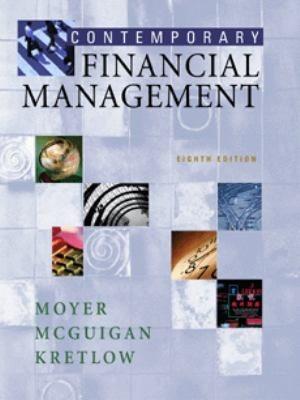Question
Depreciation and amortization are treated like fixed costs: in the calculation of the degree of pretax cash flow operating leverage. in the calculation of the
Depreciation and amortization are treated like fixed costs:
| in the calculation of the degree of pretax cash flow operating leverage. | ||
| in the calculation of the degree of accounting operating leverage. | ||
| for cash flow purposes. | ||
| for computing dividend. |
2.5 points
QUESTION 4
If the degree of accounting operating leverage is 1.3 for a firm, then a 10 percent increase in revenue should drive a:
| 12% increase in pretax operating cash flows. | ||
| 13% increase in EBIT. | ||
| 30% increase in EBIT. | ||
| 1.3% increase in pretax operating cash flows. |
2.5 points
QUESTION 5
Which is the term used to define how many units must be sold for pre-tax operating cash flow to be equal to zero?
| Pre-tax accounting operating profit break-even point | ||
| Pre-tax operating financial leverage break-even point | ||
| Pre-tax accounting sensitivity break-even point | ||
| Pre-tax operating cash flow break-even point |
2.5 points
QUESTION 6
The difference between revenue and variable cost is called:
| total contribution. | ||
| net profit. | ||
| EBIT. | ||
| EAT. |
2.5 points
QUESTION 7
Which of the following statements is true of the economic break-even point?
| It is the number of units that must be sold for accounting operating profit to equal $0. | ||
| It is the level of unit sales at which cash flows or profitability for one project alternative switches from being lower than that of another alternative to being higher. | ||
| It is the number of units that must be sold each year during the life of a project so that the NPV of a project equals $0. | ||
| It is the number of units that must be sold for pretax operating cash flow to be $0. |
2.5 points
QUESTION 8
Astroscope Tours finds that if it were to increase its price by 10 percent, it would have a 6 percent reduction in the NPV of its new 3-Hour Tour. Considering other things to be unchanged, Astroscope's analysis could be described as:
| Monte Carlo simulation. | ||
| break-even analysis. | ||
| sensitivity analysis. | ||
| variance analysis. |
2.5 points
QUESTION 9
If a firm were interested in knowing the effect of a single input change on the net present value of a project, then the firm would most likely want to perform:
| a Monte Carlo simulation. | ||
| a scenario analysis. | ||
| a sensitivity analysis. | ||
| a break-even analysis. |
2.5 points
QUESTION 10
Scenario analysis can help a firm to:
| understand the degree of uncertainty that a different set of project-affecting circumstances may hold. | ||
| eliminate all of the uncertainty that a different set of project-affecting circumstances may hold. | ||
| transform a risky project into a risk-free project. | ||
| understand the degree of certainty that a similar set of project-affecting circumstances may hold |
Step by Step Solution
There are 3 Steps involved in it
Step: 1

Get Instant Access to Expert-Tailored Solutions
See step-by-step solutions with expert insights and AI powered tools for academic success
Step: 2

Step: 3

Ace Your Homework with AI
Get the answers you need in no time with our AI-driven, step-by-step assistance
Get Started


